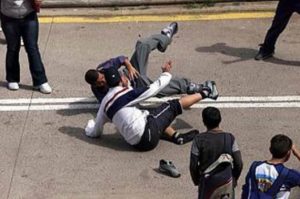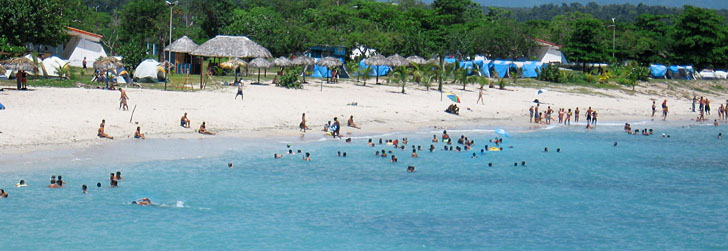The Guatao is a small town in the province of Havana, founded in 1750, located not far from the west bank of the Bauta stream that flows into the north western coast and where agriculture is the main source of employment and in which They celebrate, as in all, traditional festivals of popular roots.
In relation to the popular phrase: It ended as the festival of Guatao, circulating various versions and according to the references collected by Samuel Feijoó in his book “Cuban Mythology” in a dance held last century in that place in Havana on an unspecified date originated a huge fight between the attendees.
It is said that among the participants in the jolgório was a very beautiful and provocative woman named, Fela Cuesta, whose coquetries with several of the men, and spent little drinks, ignited the fire that led to the brawl of yore, which seems to be the story closer to reality.
A relational anecdote circulates around the event with a woman named Mama Kindimba, who liked to organize small parties at her home on weekends with the participation of workers from the nearest sugar mills where some people talked, others danced and sang to the beat of music.
The dance was called “Tambor de Yuca” which included the participation of the blacks of the Tahoro, Maurín, San Joaquín and San Antonio de Macastá mills and it is said that one afternoon a tumultuous row broke out where there were “40 broken stools, 70 heads and a good number of broken arms and legs and other injuries.
The improvisation is a variant of the Cuban peasant music that motivates heated controversies that can lead to verbal offense and it is said that in one of those guateques the interpreters decided to go from the verses to the blows and in less than a blink of an eye the anger involved all the participants.
Some say that a day of festivities in that rural town back in 1896 a section of 200 soldiers, civil guards and Spanish volunteers, commanded by a sergeant, in reprisal for their support to the insurgents attacked the residents with balance 18 dead and 32 serious wounded who later died.
Other rumors attributed the brawl to the heels given by a woman to her jealous husband, the blows and machetes between black congos and the anger of local peasants who assaulted a shoemaker for the poor quality of footwear, damaged during some lively celebrations passed by Water.
On this famous festival run countless versions. But who in Cuba has not used this popular phrase, to say that the end of some event ends tragically? Undoubtedly, what ends up as “the party of Guatao” ends badly. Specifically, in fight, blows, and even with dead and wounded.
Relationship: In that town a party ended badly.
FRASES POPULARES CUBANAS: “SE TERMINÓ COMO LA FIESTA DEL GUATAO”
El Guatao es un pequeño poblado de la provincia de La Habana, fundado en 1750, situado no lejos de la orilla oeste del arroyo de Bauta que desemboca en la costa norte occidental y donde la agricultura constituye la principal fuente de empleo y en el que se celebran, como en todos, fiestas tradicionales de arraigo popular.
En relación con la popular frase: Terminó como la fiesta del Guatao, circulan diversas versiones y según las referencias recogidas por Samuel Feijoó en su libro “Mitología Cubana” en un baile celebrado el siglo pasado en ese paraje habanero en fecha sin precisar se originó una descomunal riña entre los asistentes.
Se afirma que entre los participantes en el jolgório se encontraba una mujer muy bella y provocativa nombrada, Fela Cuesta, cuyas coqueterías con varios de los hombres, ya pasaditos de tragos, prendió el fuego que originó la trifulca de marras, que parece ser la historia más cercana a la realidad.
En torno al hecho circula también una anécdota relacional con una señora llamada mamá Kindimba, quien gustaba de organizar pequeños guateques en su hogar los fines de semana con la participación trabajadores de los ingenios azucareros más cercanos donde conversaban unos, otros bailaban y cantaban al compás de la música.
Al bailable se le llamada “Tambor de Yuca” que incluía la participación de los negros de los ingenios Tahoro, Maurín, San Joaquín y San Antonio de Macastá y se dice que una tarde se origino una riña tumultuaria donde hubo “40 taburetes rotos, 70 cabezas y un buen número de brazos y piernas partidas y otras lesiones
La improvisación es una variante de la música campesina cubana que motiva encendidas controversias que pueden llegar a la ofensa verbal y se cuenta que en uno de esos guateques los interpretes decidieron ir de los versos a los golpes y en menos de un abrir y cerrar de ojos la bronca involucró a todos los concurrentes.
Cuentan algunos que un día de festejos en aquella localidad rural allá por 1896 una sección de 200 soldados, guardias civiles y voluntarios españoles, al mando de un sargento, en represaria por su apoyo a la insurrectos arremetió contra los moradores con balance 18 muertos y 32 heridos graves quienes más tarde fallecieron.
Otros rumores atribuyen la reyerta a los taconazos propinados por una mujer a su marido celoso, los puñetazos y machetazos entre negros congos y al enfado de campesinos del lugar que agredieron a un zapatero por la mala calidad del calzado, deteriorado durante unos animados festejos pasado por agua.
Sobre esta famosa festividad corren infinidad de versiones ¿Pero quién en Cuba no ha usado esta popular frase, para decir que el final de algún suceso concluye de manera trágica? Sin dudas, lo que termina como “la fiesta del Guatao” acaba mal. Específicamente, en pelea, golpes, y hasta con muertos y heridos.
Relación: En ese poblado una fiesta terminó muy mal.
Agencies/Arrajatabla/Alberto Denis/Internet Photos/ArNoldo Varona/TheCubanHistory.com
THE CUBAN HISTORY, HOLLYWOOD.








